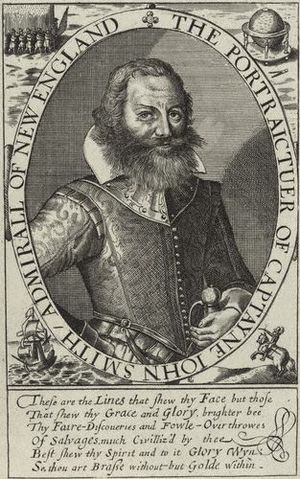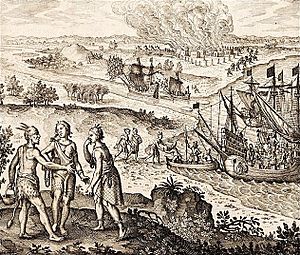Pocahontas facts for kids
Quick facts for kids
Pocahontas
Rebecca Rolfe |
|
|---|---|

Portrait engraving by Simon de Passe, 1616
|
|
| Born |
Matoaka, later known as Amonute
c. 1596 |
| Died | March 1617 (aged 20–21) |
| Resting place | St George's Church, Gravesend |
| Known for | Association with Jamestown colony, saving the life of John Smith, and as a Powhatan convert to Christianity |
| Title | Princess Matoaka |
| Spouse(s) | |
| Children | Thomas Rolfe |
| Parent(s) | Wahunsenacawh/Chief Powhatan (father) |
Pocahontas was a Native American woman. She was born around 1595 and died on March 21, 1617. She helped keep peace between the Powhatan people and the English colonists. These colonists built a settlement called Jamestown in Virginia in 1607. A famous story says she saved the life of Captain John Smith. Her father, Chief Powhatan, was supposedly about to kill him.
During a conflict with the English, Pocahontas was captured. While held by the English, she became a Christian and was named Rebecca. She also learned more English. In 1614, she married John Rolfe, a tobacco farmer. They had a son named Thomas. In 1616, Pocahontas, Rolfe, and Thomas traveled to London, England. There, Pocahontas became a well-known person. She died in Gravesend, England, and was buried on March 21, 1617.
Contents
Pocahontas's Life
Early Years and Family
Pocahontas was likely born around 1597. Her father was Powhatan, the powerful chief of many tribes in Virginia. Her mother was a common woman. Pocahontas was first named Amonute. By age ten, people called her Pocahontas, which meant "playful one." She also had a secret name, possibly Makoata, known only to her parents.
Her childhood was like other girls in her tribe. She helped with chores like cooking, gathering food, and tending crops. These crops included corn, beans, and squash. In the evenings, she listened to stories and songs about her people's history and gods. She also wove cords with other girls by the fire.
Meeting John Smith
Pocahontas was about ten years old when Captain John Smith arrived in Virginia in April 1607. Smith and his men built the Jamestown settlement. In December 1607, an Indian group captured Smith. He was taken to Powhatan's village. Smith enjoyed a feast and talked with Powhatan. He did not meet Pocahontas at this time.
Pocahontas later became friends with Smith and the colonists. She often visited Jamestown. When the colonists were starving, Pocahontas brought them food. As Jamestown grew, the Powhatan people worried about their land. Fights began. In late 1609, Smith went back to England. The settlers told the Powhatan people that Smith had died. Pocahontas then stopped visiting Jamestown. She later learned that he was alive in England.
The famous story of Pocahontas saving Smith's life is not true. Smith created this story in 1616.
Her Capture
As Jamestown grew, more English settlements were built along the James River. This led to more conflicts between the Powhatan people and the English. In April 1613, Captain Samuel Argall learned that Pocahontas was visiting a village on the Potomac River. He tricked her into coming aboard his ship and captured her. Argall demanded that Powhatan release English prisoners. He also wanted the return of stolen weapons and tools.
Chief Powhatan did not act right away. Pocahontas was held captive for about a year. During this time, she learned more English. She also chose to become a Christian and adopted English ways of life. When her father finally released his prisoners and returned some tools, Pocahontas was upset. She told him he cared more about axes and guns than his own daughter. She also told her people she preferred to stay with the English.
Marriage to John Rolfe
Some historians believe Pocahontas married a warrior named Kocoum before her capture. We do not know where they lived or if they had children. This marriage likely ended when she was captured by the English in 1613.
During her captivity, Pocahontas met John Rolfe. He was a 28-year-old colonist. Rolfe was a widower and a successful tobacco farmer. He was a kind and religious man. He wrote a letter to the governor asking for permission to marry Pocahontas. He said he loved her and believed he would be helping her soul. He also said his reasons were for the good of the colony and for God's glory.
In early April 1614, Pocahontas became a Christian. She was baptized and given the name Rebecca. Pocahontas and Rolfe married on April 5, 1614. The wedding took place either in Jamestown or Henricus. The couple lived on Rolfe's farm across the James River from Jamestown. They had one son, Thomas Rolfe. His exact birthdate and birthplace are unknown. He might have been born in America or England. This marriage brought many years of peace between the colonists and Powhatan's tribes.
Journey to England
The English wanted to encourage more people to invest in the colony. So, Pocahontas traveled to England in 1616 with a few other Powhatan people. She was shown as a symbol of the "tamed" New World. She also showed that the settlement was successful. John Smith did not meet Pocahontas in London. But he asked Queen Anne to treat her with respect. He said that if she was not treated well, she might turn away from Christianity. He also warned that England might lose a chance to gain a kingdom through her. Pocahontas then attended many events, balls, and parties. She also spent time with important ladies.
The Bishop of London treated her with great honor. Even though Pocahontas was not a princess, she was presented to the public as one. Many English people at this time believed Powhatan was the ruler of an empire. So, they gave his daughter the status they thought she deserved. A religious writer named Samuel Purchas met Pocahontas in London. He wrote that she impressed everyone with her dignified manner.
Her Death
In March 1617, the Rolfes boarded a ship to return to Virginia. Pocahontas became very ill. As the ship neared Gravesend, it was clear she was dying. She was taken to an inn on shore and died on March 21, 1617. Her funeral was held the same day at St. George's Church in Gravesend.
John Rolfe then sailed for Virginia. His two-year-old son, Thomas, was also ill. Rolfe thought the boy would not survive the sea journey. So, he left Thomas with Sir Lewis Stukely, an official in Plymouth, England. Thomas was later picked up by Rolfe's brother, Henry. Thomas never saw his father again. Pocahontas was buried under the church's main altar. In 1727, the church burned down. Pocahontas's bones were reburied in a grave in the churchyard. In the 1920s, attempts to find Pocahontas's bones were not successful.
Images for kids
-
John Gadsby Chapman, The Baptism of Pocahontas (1840). A copy is in the US Capitol.
-
A statue of Pocahontas outside St George's Church, Gravesend, Kent.
-
First Lady Edith Wilson, who was a descendant of Pocahontas.
-
Senator Jeanne Shaheen, who is also a descendant of Pocahontas.
See also
 In Spanish: Pocahontas para niños
In Spanish: Pocahontas para niños










